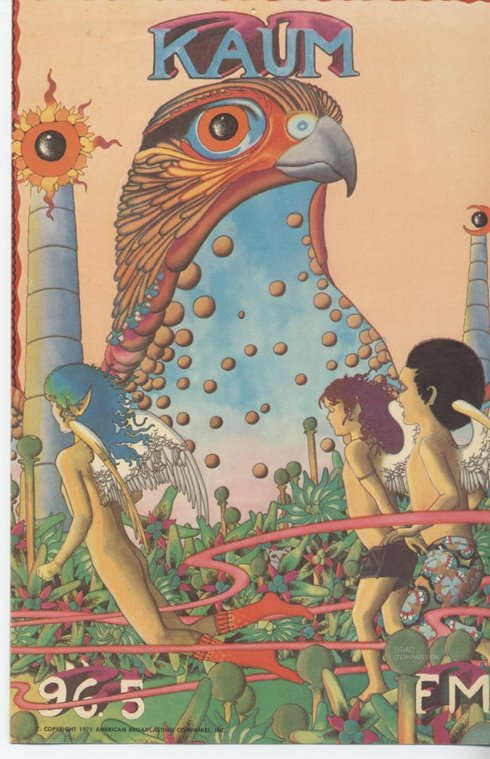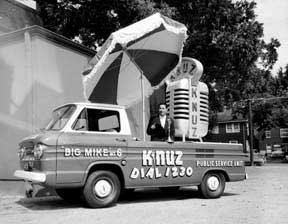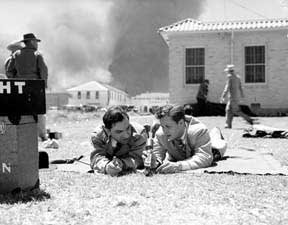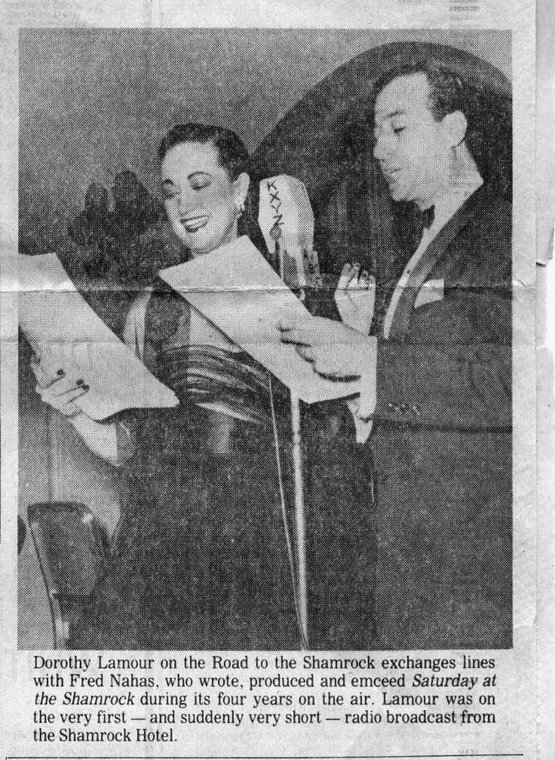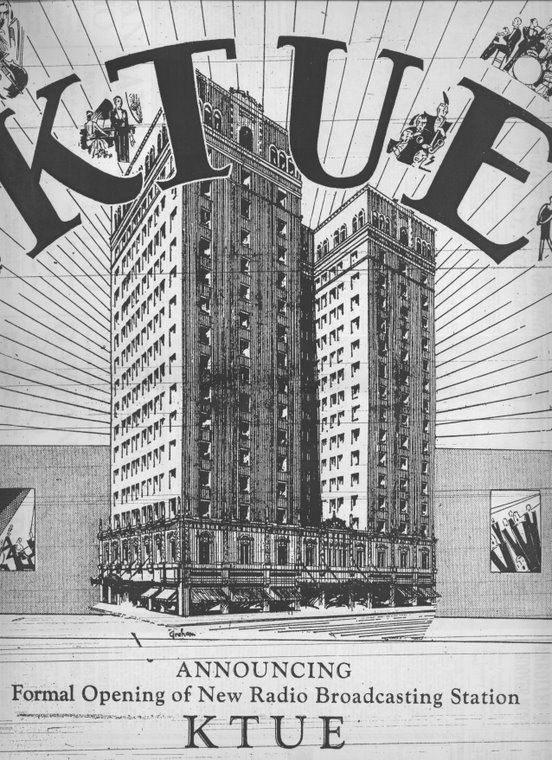The 1960s - KIKK, Talk Radio, KODA, KENR
Most of the new station activity in Houston in the 1960s would take place on the FM dial; it was to be as active an era on FM as the 1920s or 1940s had been on AM. By mid-October, 1960, there were already two new FMs on the air as KARO-FM took to the air at 94.1 megacycles the weekend of the 15th and 16th. There will be more about this in the FM Chronology. Normally the launch of a new station would have had the radio industry buzzing but not only was there little publicity regarding the launch of KARO, industry types and many others were busy talking that weekend about the news of a Vice Squad raid at the offices of KILT. It was front page news in the Chronicle on the 15th with a follow-up story on Sunday. It seems the HPD Vice Squad had gotten a tip there was an office pool at KILT and, equipped with a betting slip provided by the anonymous tipster and a marked $1 bill, moved in on Friday afternoon. An undercover officer entered the station at 500 Lovett Blvd. and said he was there to place a bet. The slip and money were taken by a young copy writer, whose name is omitted here to protect the innocent. The officer then went back outside and motioned to the uniformed officers to move in. The copy writer was promptly arrested and just as promptly fainted.
The problem seemed to be that bets had been taken from persons outside the employ of KILT; one account alleged an employee of Air Call, which was located across the lobby from the KILT offices and I believe co-owned, had been allowed to place a bet the previous week and the young woman said she thought the man was an employee of one of the other companies in the building; she also had reportedly commented after the undercover officer left that she didn’t think they should be taking bets from non-employees. Felony bookmaking charges were filed; the $1000 bond was posted by the station.
Station Manager Bill Weaver was indignant. The next day Mayor Lewis Cutrer called Weaver to apologize for the raid and both men agreed the Vice Squad should have better things to do, but the Vice Squad officer who set up the raid, Capt. H. L. Ellisor, and the Police Chief both backed the action. The total netted in the raid was 11 betting slips and $9.00 (two of the bettors had not anted up). Weaver observed the Vice Squad must have been very busy the previous week during the World Series as there had been rumors of $1000 betting pools in town; Ellisor said no raids had taken place because no complaints had been filed. Weaver also said he had been told there was a betting pool at HPD the previous week.
In mid-December the Chronicle’s Open Mike column published an article headed ‘Dial a Station and Talk, Talk, Talk’ noting a growing trend of telephone talk shows on the radio. KXYZ had launched an evening program called Expressions a few months earlier and was so pleased with the results, plans were already being made to add more talk shows after the Christmas season, according to GM Cal Perley, but this did not come to pass. A change of ownership in a few months led to cancellation of Expressions and dismissal of some employees; the show would resurface later on KFMK-FM.
KTRH had noted the trend and launched a call-in program called ‘At Your Service’ which took calls on a wide range of topics. The Chronicle article opined that eventually talk, talk, talk might become so pervasive there’d be little room for rock ‘n roll on the radio. It took the rise of FM radio and a couple of other factors but that prediction, which must have seemed highly unlikely at the time, eventually came true.
Whether Expressions was the first listener participation talk show in Houston is not known and the Chronicle did not mention any other local stations that had latched on to the trend.
In the same column the Chronicle reported that KNUZ program director Ken Grant was talking about an unusual success story for that time of year, an album doing a brisk business and drawing lots of listener calls that had nothing to do with Christmas. The Humorous World of Justin Wilson had been aired on both KNUZ and sister station KQUE-FM and there were reports it was breaking sales records.
On March 19, 1961, formal transfer of ownership of KTHT to Winston-Salem Broadcasting from Texas Radio was completed. General Manager Sam Bennett resigned and the new owners unveiled a new moniker for the station, Red Carpet Radio. Within a few months the station would become known as Demand Radio 79.
On May 1, 1961 KRCT changed call letters to KIKK, again proclaiming the switch in a big ad in the Chronicle. A story in the TV section of the Chronicle the previous day helpfully noted the DJs would refer to the station as ‘kick,’ ‘for kicks.’ Owner Leroy Gloger told the Chronicle reporter the change came about because research had shown call letter confusion among listeners. By that time, the station had studios in the Montague Hotel at 804 Fannin at Rusk as well as in Pasadena.
According to Roy Lemons, who worked for KIKK during most of the 1960s as Sales Manager, the KIKK call letters were the idea of a San Antonio country broadcaster A.V. 'Bam' Bamford, who owned KBER in San Antonio. Bamford knew that the calls had been dropped by a California station. He also came up with the "boots" symbol over a drink at the Montague. The logo was designed by Don Newcomer, a Heights resident who charged $250 for the soon-to-be-famous KIKK design.

This ad in May, 1961, just used block lettering for the call letters; it is not known yet just when the familiar boots came to be used for the ‘K’s.
This image appeared in the Sam Houston High School yearbook for 1963 and is apparently of the side of the KIKK studio building on E. Sterling. At the left end of the fence, note the partially obscured sign for the station hanging on the front of the building. According to other information found online the building also housed a recording studio, perhaps after KIKK moved out.
This business card type ad appeared in the Pasadena High School yearbook for 1964.
I am grateful to Tori Mask of the South Belt Houston Digital History Archive who found these images and allowed me to use them.
In the first week of June the FCC approved the transfer of KXYZ from NAFI Corp. of Los Angeles to Public Radio Corporation of Houston. The new owners consisted of Lester and Max Kamin of Houston and Morris Kamin of Victoria; they also owned stations in Tulsa and Kansas City. Lester Kamin had been involved in advertising and radio since at least the 1940s when he was a disc jockey in an era when disc jockeys were often well known people who hosted shows spinning records in addition to their other jobs. Sam Bennett, formerly of KTHT, came aboard as GM and Milt Willis, PD of KTHT, came aboard as the new Program Director.
Within a few days, Bill Roberts’ column in the Post announced that Cal Perley and Ken Collins had departed KXYZ. They had been closely associated with the Expressions program and announced they were already talking to KFMK about re-launching the program there.

July 31, 1961 saw the beginning of KODA-AM at 1010 kc, a daytimer and the first new Houston AM radio station in more than a decade, joining its sister station KODA-FM which had taken over KPRC-FM in 1958 as KHGM-FM and recently changed call letters to KODA-FM. KODA-AM brought the ABC Radio Network back to Houston; ABC had been dropped by KXYZ several years earlier and carried for a while by KWBA, Baytown. The station featured ‘good music’ news, sports and a traffic helicopter, the KodaBird. KODA-AM and FM were owned by Paul Taft of Taft Broadcasting who originally had been General Manager of KGUL-TV, Channel 11, Galveston in 1953. Taft also owned the Muzak franchise for Houston. Westinghouse Broadcasting, Group W, bought KODA-AM and FM in 1978 and quickly spun off KODA-AM which changed call letters to KLAT, La Tremenda, obtained permission to become a 24 hour operation, and still operates on 1010. The KLAT calls went into use on August 29, 1979.
The picture above shows the new building at 4810 San Felipe which housed the KODA-AM and FM operations. Roche Bobois now occupies the building. The building in back, added sometime after 1961, housed Taft's non-broadcast businesses.
KANI, Wharton, signed on June 17, 1962, at 1500 kc and those calls are still in use.
At the end of June, 1967, LIN Broadcasting of Nashville purchased KILT and KOST-FM from Gordon McLendon for $15 Million dollars. McLendon said he had plans to purchase a UHF station in the market when one became available.
January 17, 1968, KENR, ‘Keener,’ became only the second new AM signal in the market in the decade at 1070 kc. Originally a daytime only station, KENR expanded to 24 hour a day operation within a couple of years. The format was country.
Bill Edwards of Saginaw, MI, was the owner and he told Chronicle TV/Radio reporter Ann Hodges the station was the culmination of a nine year dream. Edwards, who had apparently never even been to Houston before his permit was granted, said nonetheless he had been fascinated by Houston for years and considered it the ‘most exciting and most profitable of major radio markets’ and was proud of his engineers for finding a way to squeeze the station in on the crowded dial. Jack Fiedler of WNUS, Chicago, was to be the first General Manager. Edwards also owned WKNX-AM/TV in Saginaw.
Although the station had a good run as a country station, it eventually left that field to KILT-AM/FM and KIKK-AM/FM. The station tried country gold and then aired a radio magazine format for a while. For a while it was known as KRBE-AM and carried classic rock and simulcast KRBE-FM. The call letters in use on 1070 now are KNTH; it is a newstalk station.
Brief Postscript on the 1970s
In 1974, KEYH, started broadcasting at 850 kc; originally a news station it’s now a Spanish station, still operating with the same call letters. Also that year, KACO, Bellville, signed on at 1090 kc. The station on that frequency now uses the old Houston call letters KNUZ and is a Hispanic religious station.
To be Continued.






